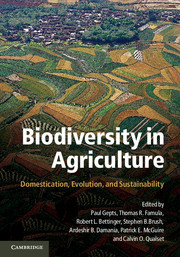Book contents
- Frontmatter
- Contents
- Tables
- Figures
- Foreword
- Contributors
- Acknowledgments
- Introduction: The Domestication of Plants and Animals: Ten Unanswered Questions
- 1 The Local Origins of Domestication
- Section I Early Steps in Agricultural Domestication
- Section II Domestication of Animals and Impacts on Humans
- Section III Issues in Plant Domestication
- Section IV Traditional Management of Biodiversity
- 17 Ecological Approaches to Crop Domestication
- 18 Agrobiodiversity Shifts on Three Continents Since Vavilov and Harlan: Assessing Causes, Processes, and Implications for Food Security
- 19 Indigenous Peoples Conserving, Managing, and Creating Biodiversity
- 20 Land Architecture in the Maya Lowlands: Implications for Sustainability
- 21 Agrobiodiversity and Water Resources in Agricultural Landscape Evolution (Andean Valley Irrigation, Bolivia, 1986 to 2008)
- Section V Uses of Biodiversity and New and Future Domestications
- Index
- References
18 - Agrobiodiversity Shifts on Three Continents Since Vavilov and Harlan: Assessing Causes, Processes, and Implications for Food Security
Published online by Cambridge University Press: 05 June 2012
- Frontmatter
- Contents
- Tables
- Figures
- Foreword
- Contributors
- Acknowledgments
- Introduction: The Domestication of Plants and Animals: Ten Unanswered Questions
- 1 The Local Origins of Domestication
- Section I Early Steps in Agricultural Domestication
- Section II Domestication of Animals and Impacts on Humans
- Section III Issues in Plant Domestication
- Section IV Traditional Management of Biodiversity
- 17 Ecological Approaches to Crop Domestication
- 18 Agrobiodiversity Shifts on Three Continents Since Vavilov and Harlan: Assessing Causes, Processes, and Implications for Food Security
- 19 Indigenous Peoples Conserving, Managing, and Creating Biodiversity
- 20 Land Architecture in the Maya Lowlands: Implications for Sustainability
- 21 Agrobiodiversity and Water Resources in Agricultural Landscape Evolution (Andean Valley Irrigation, Bolivia, 1986 to 2008)
- Section V Uses of Biodiversity and New and Future Domestications
- Index
- References
Summary
If we consider the “life cycle” of a domesticated species, we might divide it into six phases: (1) wild harvesting and (potentially) disruptive selection; (2) incipient cultivation and adaptation to agro-habitats; (3) domestication through cultural selection of a limited gene pool in agro-habitats; (4) diffusion and adaptation to other agro-habitats, with potential introgression with wild or domesticated relatives; (5) diversification and further selection through intentional breeding or fortuitous introgression; and (6) local extirpation and in some cases, global extinction. Although science historians primarily regard Nikolai Vavilov and Jack Harlan in terms of their contributions to our understanding of crop domestication and diffusion (Nabhan 2009), they were actually intellectually and practically engaged to some extent in observing and reporting on all six of the phases noted above.
Since the deaths of Vavilov and Harlan, there has been tremendous progress made in our scientific understanding of the first five phases in these crop life cycles, thanks to innovative collaborations among geneticists, archaeologists, biogeographers, ethnobiologists, and agricultural historians. However, one might argue that our scientific understanding of crop extirpation and extinction processes has lagged far behind that which conservation biologists have gained for wild species. While the body of scholarly literature on agricultural origins and dispersals has grown exponentially since the pioneering work of Vavilov, Sauer, Harlan, deWet, Zhukovsky, Zohary, and Darlington, we have largely seen anecdotal evidence and emotive interpretations regarding the causes, cultural processes, and consequences of genetic erosion, local crop extirpations, and global extinctions. There are exceptions, of course, such as the fine work of Stephen Brush, his colleagues, and students, but these notable exceptions prove the rule.
- Type
- Chapter
- Information
- Biodiversity in AgricultureDomestication, Evolution, and Sustainability, pp. 407 - 425Publisher: Cambridge University PressPrint publication year: 2012
References
- 1
- Cited by



